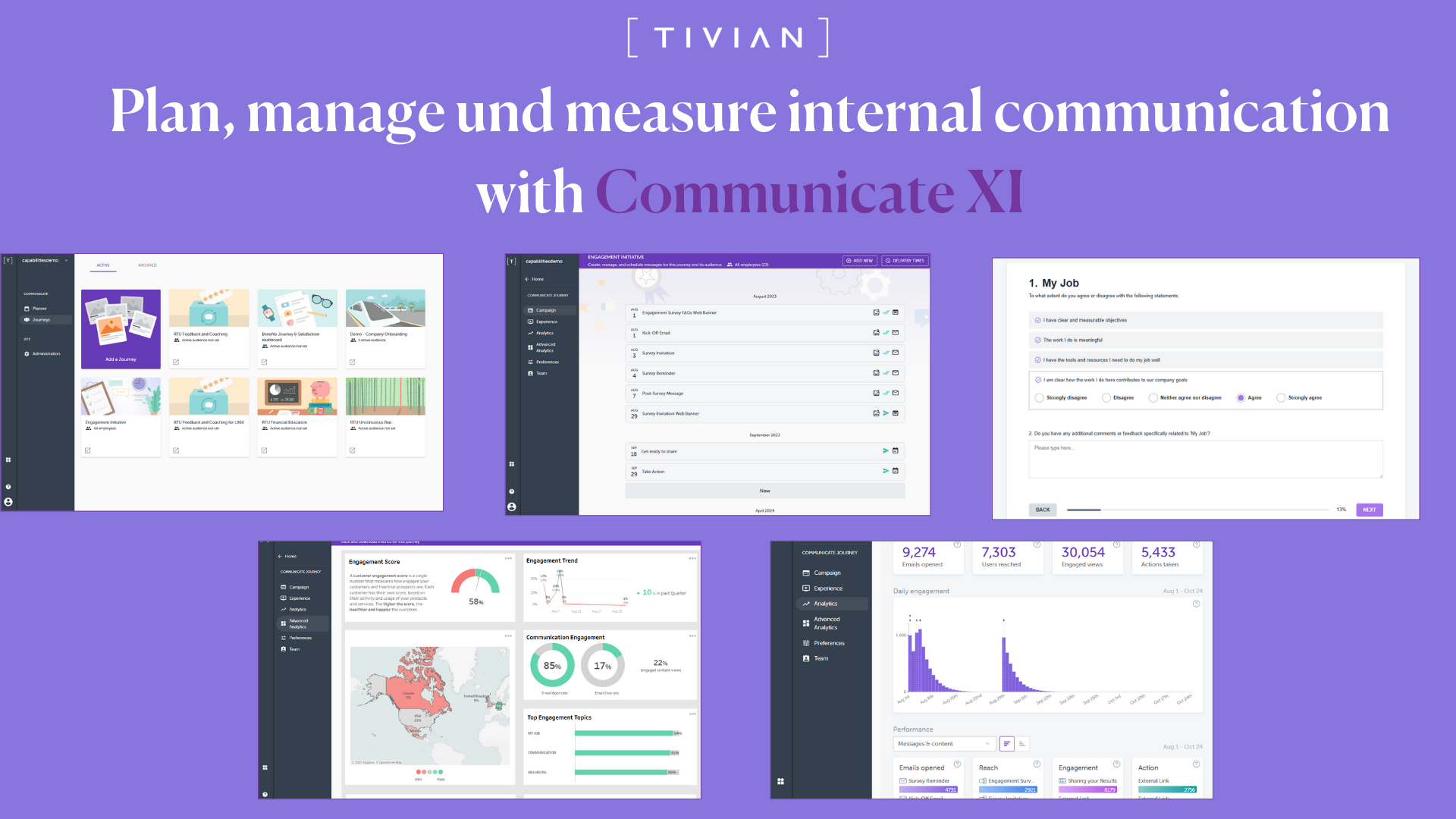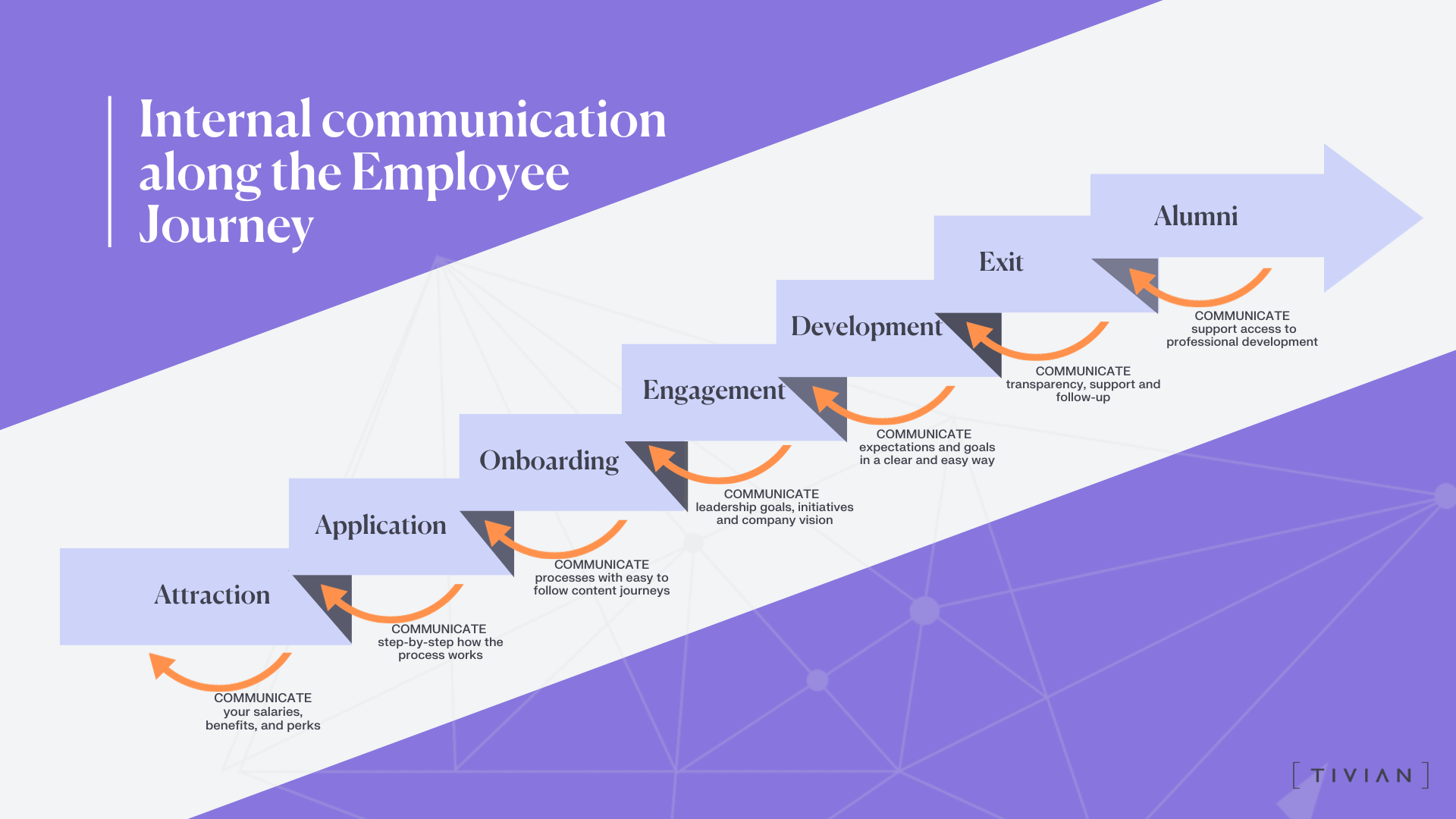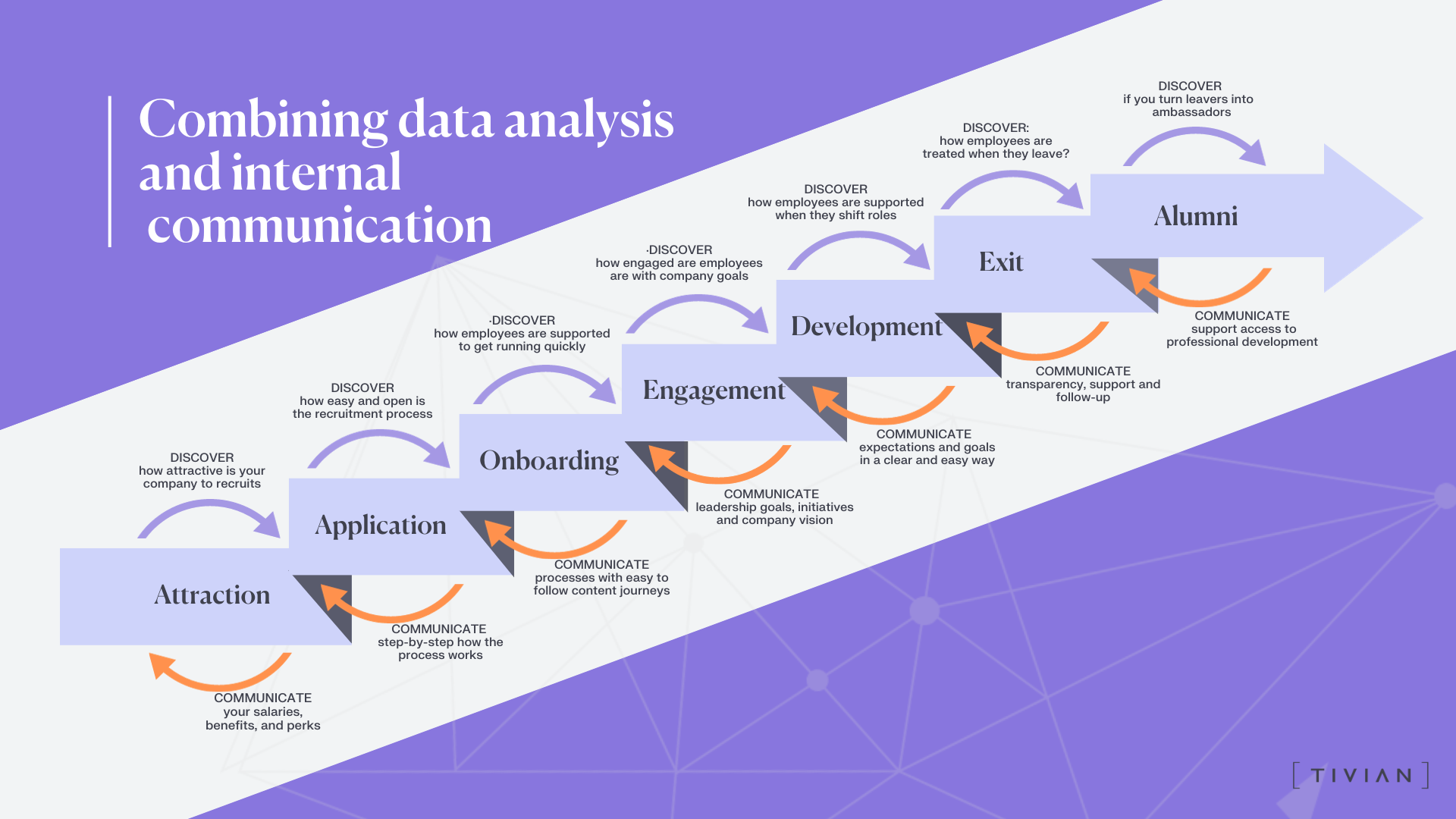The importance of internal communication to business success and how it works today
Even with the rise of technology and AI, organisations rely on their people to be successful. That makes internal communication vital to business operations, both to keep employees informed and up to date with clear information, and to listen and act on their feedback. Effective internal employee communication increases engagement, boosts productivity and creates ambassadors for your brand.
Find out what internal communication is, what the challenges are to implementing it successfully and how it can be improved.
- What is internal communication?
- What are the goals of internal communication and why is it so important?
- What is important in internal communication?
- What internal communication tools are there?
- How can internal communication be improved?
- How will internal communication evolve in the future?
What is internal communication?
Internal communication (IC) is how your organisation shares information so employees can perform their jobs effectively, feel connected and remain informed.
Done well, internal communication acts as an organisation’s nervous system, linking different teams, offices, and departments so that they can see the bigger picture, understand wider objectives and feel part of the company and its culture. It should share information both up and down the organisation and laterally between teams and departments.
Internal communication in an organisation can be managed or ad hoc and can come from:
- Senior leadership (such as CEO updates on strategy and progress on objectives – top-down communication)
- Managers (such as to their team or department – top-down communication)
- Peers (to colleagues either in their team or across departments – lateral communication)
- Employees (providing feedback or questions to managers or leaders – internal upward communication)
It can use a variety of channels, including:
- Verbal (face-to-face meetings either in person or online)
- Paper-based (newsletters, posters)
- Electronic (emails, intranets, company apps, videos)
Internal communication can be delivered via company wide channels (such as a newsletter or CEO briefing), one-to-many (a manager to their team), one-to-one or two-way (such as a team meeting).
What are the goals of internal communication and why is it so important?
1. Greater productivity
At its most basic level, internal business communication provides an employee with the information they need to effectively carry out their role. This could include access to the processes they need to follow, how to operate any required technology or systems, plus all company policies around administrative tasks such as booking holiday.
2. Closer alignment with objectives
Everyone works more effectively if they understand (and share) the company’s goals, strategy, and objectives. That’s why engaging teams around purpose, strategies and value was, for the second year in a row, the top priority for most communication and HR leaders, according to Gallagher’s 2022/2023 State of the Sector report. This is a key area for improving HR communications best practice, as the same study found that only 56% of leaders believed their employees understood the organisation’s strategy, vision, and purpose,
3. Increase employee engagement
Internal communication and employee engagement are closely linked. Strong internal communication builds a sense of belonging that increases employee engagement and morale. It empowers staff members with the information they need to do their job, gives clarity on their goals and provides a channel to share praise and rewards. Read more about the link between internal communication and employee engagement in our blog.
4. Building a strong culture
Creating an open, transparent culture that involves all employees is key to driving the right behaviours and aligning people with corporate values. Sharing information is essential to building a transparent organisation, meaning internal communication nurtures company culture.
5. Managing through change and crises
In a fast-moving world, organisations face challenges from new competitors, new ways of working (such as digitisation), or changing customer needs. That requires internal transformation and change management. Internal communication is central to this process, keeping employees informed and up to speed and minimising the potential for disengagement and misunderstanding.
Internal communication also comes to the fore during crisis situations. This was particularly evident during the COVID pandemic, when many CEOs took the lead on internal communication, holding video meetings and town halls to keep staff updated and to give them the chance to get their pressing questions answered.
6. Creating brand ambassadors
The view a customer has of a brand is normally shaped by the interactions they have with frontline staff, whether an agent in the contact centre, an assistant in a shop or an engineer installing or fixing an appliance. You want all of your staff to be informed, positive ambassadors for your brand. Effective internal communications deliver this alignment, helping boost your reputation and retain customers.
7. Meeting legal requirements
For many organisations, communicating policies and procedures, such as around health and safety, is a legal imperative. Failing to share the right information and checking that it is completely understood can lead to prosecution in the case of accidents, with the potential for financial penalties alongside reputational damage. Other information, such as changing contractual terms or announcing restructuring or redundancies also needs to be handled through internal communications to ensure that legal processes are followed.
8. Enabling two-way communication
One of the most important internal communication ideas is to build a two-way, ongoing conversation across the company. Collecting feedback from employees, acting on their insight and following up to close the loop is vital to a healthy, productive culture, where employees feel heard, valued and engaged.
What is important in internal communication?
Internal communication is not new – in fact the first internal company magazines came out in the 19th century. However, as it has grown in strategic importance, so have the challenges to success. Today IC teams have to overcome five key challenges to deliver effective, engaging communications
Changing demographics
Every demographic wants to consume and engage with content in different ways. That means that the channels used to communicate have to evolve to meet the needs of different generations. For example, younger workers are more likely to respond well to shorter or video-based messages whereas older employees may well prefer longer-form written content. The challenge for IC teams is that organisations today have multigenerational workforces, meaning they need to use a range of tactics to reach their audiences.
Changing working patterns
For many companies hybrid working is now the norm, with staff splitting their time between home and office. This brings two issues. Firstly, it can make it difficult to organise face-to-face communication events that everyone can attend, while secondly it can lead to a disconnect between home-based employees and the company itself. Ensuring that everyone, wherever they are based, is engaged and informed is therefore even more crucial.
The threat of information overload
We live in a world where volumes of information are ever-increasing. At the same time people are receiving communications across a growing number of channels. This can lead to messages being missed or not read in detail. For example, research found that 61% of respondents ignore emails in the workplace. To cope with the threat of information overload IC teams need to ensure that they are communicating relevant content through the right channels, at the right times to the right people, finetuning their approach to avoid messages being overlooked.
Coping with cultural and language differences
Organisations are increasingly global, with offices and employees across the world. Internal communication must be able to connect all of these different people, whatever language they speak and their cultural background. While a company may mandate that all communication is in English, IC teams still need to tailor messages so that they are understood by those who may not speak it as a first language and ensure that they respect cultural differences and sensitivities.
Avoiding rumours and misunderstandings
In a fast-moving, real-time world, rumours can spread quickly within an organisation, particularly if they are not quickly corrected. Internal communication teams need to be constantly vigilant when it comes to spotting potential issues and have plans in place to respond rapidly to them. They also need to ensure that any internal communications cannot be misunderstood, double-checking and testing any content before it is released.
What internal communication tools are there?
Technology has dramatically increased the range and effectiveness of internal communication tools, moving from verbal/face-to-face meetings and paper-based communication to more digital, two-way, engaging solutions.
Common internal communication systems include:
- Posters and noticeboards. These can be particularly effective in workplaces where employees don’t have access to work computers or devices, such as in factories or the restaurant/hospitality industry.
- Newsletters and magazines. These provide the opportunity to give a more in-depth perspective and can be printed or delivered electronically.
- Face-to-face meetings. These could be company or office-wide meetings led by a CEO or senior leader, or smaller group meetings led by local managers.
- Intranets. These centralise information, particularly around policies and procedures, as well as providing a staff directory to enable peer-to-peer communication.
- Providing the ability to easily distribute written messages, links and images across the entire organisation.
- Real-time communication tools and workspaces (such as Slack). These enable instant communication with individuals and teams.
- The pandemic accelerated the rise of unified communication platforms such as Microsoft Teams, which aim to combine the accessibility of video presentations with collaboration tools to increase engagement.
- Specialised internal communication platforms. Built to meet the specific needs of IC teams, these enable true, personalised communication with employees, creating a two-way dialogue at scale.
Tivian’s Communicate XI is the perfect tool for your internal communication needs. Taking inspiration from modern, data-driven marketing tactics, it allows you to cut through the noise with targeted, personalised campaigns supporting many channels, like video, email, SMS, web, and print. An intuitive dashboard also helps you keep track of all your communications activities. Communicate XI makes it easy to plan, manage, measure and scale your internal communications – just like large enterprises do.

More about the tools and their benefits.
How can internal communication be improved?
Internal communication is far too important to be left to chance – organisations need to put in place a comprehensive, planned strategy, delivered through engaging, personalised content if they want to drive success. Achieving internal communication best practices means following a multi-stage process:
- Analyse current IC activities. What is working and what needs to change? Survey employees and managers to get their insights.
- Define objectives. What are you aiming to achieve with your programme? Is it linked to specific events (such as restructuring or cultural change)?
- Understand your audiences. What are the different personas in your workforce and how can you best reach them?
- Set key messages. Linked to objectives, what messages do you want to deliver? Ensure messages are consistent, whoever is delivering them and whatever the channel. Create a messaging bible to provide guidelines for everyone involved.
- Define KPIs. Define what success looks like to enable monitoring of your programme and its effectiveness.
- Build a time-driven plan. You cannot expect to change things with a single tactical activity, so put in place a structured plan, with specific milestones and content.
- Create engaging content. Think like a marketer and create written, electronic, and video content that will resonate with your audiences. Ensure that all communications are honest, transparent and empathetic and include calls to action to kick-start two-way conversations.
- Segment and personalise. Every group of employees has particular needs – for example, a new starter requires very different information compared to an experienced staff member. Ensure you understand different needs and personalise the experience.
- Monitor and improve. Measure effectiveness and use this information to drive improvements. That means putting in place a full measurement framework before you begin your programme. Measurement should cover both tactical metrics (such as open rates of emails, page visits and logins), and higher-level engagement, such as the impact on employee engagement scores, NPS and staff satisfaction.
Above all it is vital to get senior-level buy-in and support for your programme. Internal marketing communication is as important as external marketing, so requires the right resources and leadership involvement to drive success. There is more on internal communication best practice in our blog.
Make it easy for yourself – use Communicate XI
Communicate XI guides you through the entire process: from planning, managing, measuring and then scaling your internal communications. The tool makes it easy to listen to data instead of your gut feeling.

Redesign your internal communication and adapt your campaigns to your employees. Communicate XI helps you to do this.
How will internal communication evolve in the future?
Content is becoming more personalised
Artificial intelligence gives the opportunity to provide personalised content that takes less time to create. It is precisely such individual, personalised content that will become increasingly important in the future.
Close-up, emotional content will become more important
It’s all about showing faces behind the company and finding a balance between private and close-up as well as work-related content. In the future, companies should address their employees with emotions instead of facts.
Multichannel approach: Channels must be combined sensibly
Not every channel is suitable for every piece of information. Urgently needed information must be provided directly, for example for a digital solution. In-depth information, for example interviews, can also be shared via printed employee newsletters. Internal communication must always adapt the channel to the content and adopt a multichannel approach.
This multichannel approach also offers the opportunity to respond to different employee needs.
Less is more: internal communications should keep shorter
“Snackable content” is the keyword – content that is short, simple and quick to consume. The rule here is: the shorter, the better. Accordingly, images, videos and graphics are becoming more and more important, whereas text deserts are becoming less and less appealing. This trend is intensifying, especially with the entry of Generation Z into the world of work.
Even when it comes to channel selection, it is more and more about reducing complexity – and this means that while companies should adopt a multichannel approach, they should only establish as many channels as necessary and focus on the really relevant content. Because we are in a VUCA world characterised by volatility, uncertainty, complexity and ambiguity.
Internal communication becomes an anchor in change management
In times when many changes are taking place at the same time in many companies, internal communication plays a key role for success: it prepares the information in a comprehensible and transparent way, bundles it and makes it available to all employees. In this way, internal communication accompanies the entire process, avoids rumours and reservations and ensures that all employees are informed first-hand about changes.
Internal communication must start at the beginning of the employee journey
At the beginning of the employee journey means that internal communication starts even before joining the company. Communication before application and onboarding is just as important as communication after leaving.
In other words, internal communication plays an important role along the entire employee journey.

Data analysis is gaining importance
New technologies also give internal communications teams the chance to measure, analyse and then scale their processes. Companies that underpin their internal communication with KPIs are not listening to their gut feeling, but to their employees. Data-driven communication gives the chance for relevant changes.

Take your internal communication to a new level now
Internal communication is becoming increasingly important and complex. But thanks to intelligent tools, it is also becoming easier to plan, implement and scale.
With COMMUNICATE XI, you can develop dynamic, personalised content, communicate your messages at the right time and stay on top of it all – all combined with data analytics that show what works and what doesn’t.
Get to know COMMUNICATE XI in a free demo.

